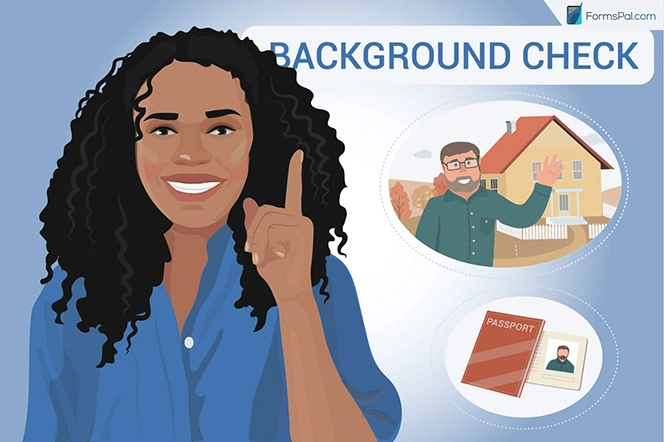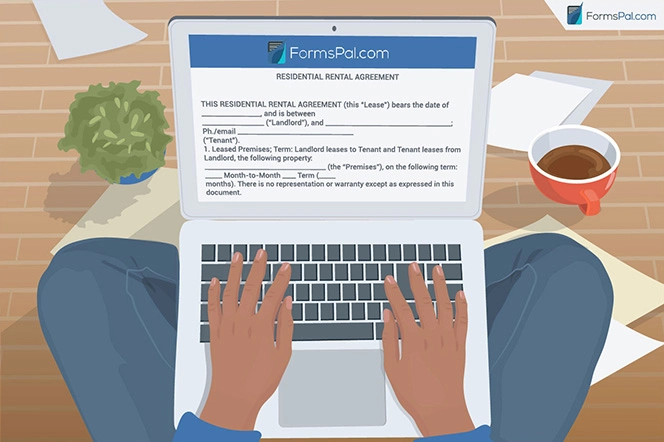What is a Residential Lease Agreement?
A residential lease agreement is a legal document between a landlord and tenant for the use of residential property in exchange for rent. The agreement outlines all the property use terms and policies. These terms should be based on state laws and reasonably indicate who will become accountable for specific occurrences. The person who will be occupying the property for a certain period of time will then review the document, and if agreeable, abide by the rules of the agreement for the period of their stay.
Lease and Rental Terms Glossary
Alterations. It’s the act of changing any part of the leased premises either aesthetically (paint) or structurally (adding extensions or removing wall dividers). Permission to make alterations inside and outside of the property must be secured from the landlord in written form.
Common Area Fee. In some apartments, condominiums, or subdivisions, a common area with additional amenities and spaces adds to the tenant's expenses.
Furnishings. A rental property may include existing furniture such as beds, chairs, desks, or appliances like refrigerators or dishwashers. The landlord may declare this in the rental lease agreement to ensure that these items remain after the tenant has moved out.
Governing Law. Legalities regarding leases vary from state to state. It is highly recommended that you check your municipal laws to make sure the agreement is enforceable.
Guarantor. In some cases, a landlord may require a guarantor from the tenant's party, who may be a friend or a relative living nearby. The guarantor will be fully responsible for any fees or damages the tenant has incurred if they fail to settle this responsibility. In some cases, the security deposit is enough to fix damages or settle past due rentals.
Indemnity. This is a paragraph or clause in the agreement stating that the landlord will not be held responsible for any injuries, accidents, or damages inside the rental property. It is best to check the indemnity clause in detail as some of it may go against state laws like "accidents that occur due to landlord's negligence in a common area."
Landlord, or Lessor. The landlord is commonly the leased property owner who may or may not have fully settled the property's mortgage payment but has the title under their name. In some cases, the landlord could also be the owner's legal caretaker.
Late Charges. For late rent payments, the landlord may stipulate a fixed amount per day, as long as this does not go above the state maximum. Some states have provisions for a certain grace period during which the tenant cannot be charged with penalties. Each state also differs in its guidelines for Insufficient funds ("NSF") checks.
Lead paint warning statement and disclosure. Any property built before 1978 most likely used lead-based paint. Since exposure to such is physiologically harmful to humans, the landlord must disclose this information through a legal attachment.
Leased Premises, or Property. This often refers to the house, office, or area being rented by the tenant in a contract. The rental lease agreement should stipulate the area and the perimeter of the property.
Maintenance. The landlord or tenant may agree on periodical upkeep for the property's maintenance, like yearly painting, gardening, or fire safety inspections.
Month's Rent. The rent amount paid monthly on the date agreed upon. This should be stated clearly, both numerically and in words.
Notices. This is the written (mailed or e-mailed) letter sent to whoever is found violating the contract (either the tenant or landlord).
Occupants. Those who live with the tenant inside the property for the agreement's duration are called "occupants." They may be relatives or friends and should also be listed in the contract.
Proration of Partial Month of Rent. Frequently, contracts are signed before a tenant moves into the property. However, if they do not stay in the property for a significant portion of the month, the month's rent may be adjusted, so they can pay what is fair.
Security Deposit. This is the amount given to the landlord before the first month's rent. A security deposit is usually equivalent to one (1) or two (2) month's rent, depending on your state. Most have no limit when it comes to the amount. It is used to cover the cost of damage or unsettled utility bills should the tenant leave the property without notice.
Tenant, or Lessee. This is a person occupying or renting the property for a certain period of time. They may or may not have other "occupants" who are not signatories to the contract.
Term. The duration or length of effectivity of the rent. This should be indicated in the agreement.
Termination. Termination of the rent may occur when either the tenant or the landlord violates the contract.
Utilities. Payment of utilities are often settled by the tenant. However, in some cases where there is no submeter for water or electricity (e.g., room inside a house), the landlord may opt to pay for this and add a fixed fee on top of the tenant's monthly bill.
Residential Lease Agreement Types
Fixed-Term Leases
This type of lease often entails using the entire rental property for a fixed period of time, usually for a minimum of one year with no limit for the number of years. These are typically used for houses, apartments, and condominium units. The downside of this residential lease is that the tenant may have to forfeit their security deposit if they leave before the term ends.
Periodic Leases or Rent
Periodic leases are also called monthly leases or "tenancy at will" because the agreement only lasts for a short period of time. They may renew the contract or terminate the rental lease agreement, provided there is a 15 or 30-day notice (depending on your state). This setup may not be for everyone since the landlord has the right to increase the month's rent without notice.
Proprietary Leases
Some apartments or condominiums are run by co-ops. In such a case, the tenant will purchase "shares" or "stocks" to become part owners of the building. The co-op group will then act as the landlord to collect the month's rent, become the building's property manager, and facilitate day-to-day operations. At the same time, the shareholders give their "monthly dues" instead of their month's rent.
Subleases
In some cases, the landlord is also a residential tenant who has secured a fixed-term agreement with the property owner. This happens through subleasing, where a smaller space like a room or a unit, for instance, is rented to someone else. However, it is crucial to go through the original rental lease agreement since this setup often becomes complicated in the long run.
Rent-to-Own
In this rare type of agreement, the landlord has the intention to sell the property, but the potential tenant cannot make a significant downpayment. In such a case, a bank loan may not be an option. So, the landlord accepts a higher security deposit and advanced rent payments. There is no limit to the number of months to pay off the rest of the "mortgage," so the landlord and tenant can determine this in writing. Once complete payment has been made, the title will be transferred to the renter.
How to Rent Out Residential Property
Do you want to rent out your property but don't know where to start? Here is a step-by-step guide to help you through that process.
Step 1. Research

The most crucial step in leasing your residential property is research. To attract a good tenant, you must check how the home compares with others. Consider the following when you do your research:
- Area. Is the property located in a good, peaceful community with nearby marketplaces, schools, and hospitals? Is it accessible by public transport or located far from the nearest busy area? These are some of the things you would want to check in comparison with other properties for rent.
- Amount. While deciding on the cost, you need to make your month's rent somewhat at par with others, not too low and not too high. An appraiser can help you with finding out a good figure to start with.
- Inclusions. With today's busy world, people look for more convenient ways to move into new homes. Therefore, it is good to know popular inclusions, which can make your offer more eye-catching. Is the property fully furnished? Does it have appliances? Is it newly refurbished? These will also affect your pricing strategy, so it's best to figure out what works best for you.
Step 2. Get an agent or use online renting platforms

Most busy landlords prefer to get real estate agents who will take care of the process's first steps. While this is the best decision for some, others prefer to do this on their own by posting online renting platforms like Airbnb, HomeAway, and VRBO.
When doing this on your own, it is best to get high-quality photos that will showcase the real estate property's interior and facade as honestly as possible. Include your contact information, and be prepared to answer phone calls and text messages throughout the day when this happens, as many potential tenants will want to get in touch. It will be helpful to save a templated message so you can quickly reply.
Step 3. Schedule a viewing

It is best to free up your time on weekends or certain parts of the day to show the rental property. You may also assign someone reliable to handle this for you. Make sure to confirm the viewers' identity and have someone with you for security purposes. Then, you may give a complete tour of the property.
Step 4. Prepare a rental application and list of requirements

As soon as the viewing is done and the potential tenant shows interest, you may give them the rental application form, asking for the contact information of their references. This document may also contain a checklist of requirements for their background check, like a copy of the government-issued IDs and police clearance certifications.
Step 5. Do a background check

Even with their papers, it is essential to do a full background check. You may call their references or get in touch with their old landlord. In some states, the landlord must go through the strict process of declaring the rental transaction to help the tenant's future landlord do a more thorough background check. You may also want to check each document that the tenant has submitted.
Step 6. Draft and revise the agreement

If you only made a checklist of your conditions, now is the time to integrate these into your residential lease agreement. It is crucial to check each paragraph's legal basis so as not to make your agreement void or illegal. Some states may have specific caps on leasing agreements' financial aspects and may have strict upkeep, penalties, and termination guidelines.
After your potential tenant reviews the agreement, he or she may ask for specific revisions. It is up to you to negotiate or remain strict with the terms outlined in the contract. If they agree, both of you must sign on each page of the document and get it notarized.
Step 7. Secure necessary financial requirements

Once you have finalized the agreement, you must get the following:
-
Security Deposit (equivalent to 30 days or 60 days, depending on state policy).
-
An advanced deposit (usually equivalent to one month's rent).
-
A check for the first month (can be prorated).
-
Post-dated checks for the succeeding months covered by the agreement.
Make sure to formally "receive" the payment by giving him or her an official receipt or a signed paper stating the rental amount, date, and purpose of the transaction.
Step 8. Turn over the keys

Likewise, the tenant must also properly receive the keys to the property. Both a landlord and tenant must document the completeness of the keys and test if they work. It will also be good to do a walkthrough inspection of the home and take additional photos of damages, leaks, and other details that show the house's current state. By doing so, both parties will know who will be responsible for future damages or wear and tear.
What Are the Rent or Lease Addendums and Disclosures?
Declaring things that may affect either party is crucial to maintain transparency. Otherwise, this could affect the agreement, and the party that withheld information may be held liable for violations. Here are some addendums and disclosures one must attach to the agreement before the rent or lease commencement.
Pet addendum. This is an additional provision for pets stating the breed and size.
Smoking addendum. It indicates which areas of the home smoking is allowed in.
Renovation addendum. Renovations can occur while the lease agreement is being finalized. It is essential to declare which parts of the property were changed for the benefit of the tenant.
Bed bug addendum. Since bed bug infestation is quite serious, the landlord may opt to add this as a rider to the agreement so the tenant can become aware of their responsibility to prevent such.
The landlord also has the responsibility to disclose any information that may affect the tenant’s living and health conditions, such as water damage, mold, and use of hazardous materials (e.g., lead-based paint, asbestos, and radon). These can be disclosed by adding riders to the agreement.
Frequently Asked Questions
Is a verbal rental agreement binding?
Verbal contracts are only binding between the two parties who agreed. However, should complications arise and the problem is taken to court, the he-said-she-said nature of this agreement will delay the process, negatively impacting both parties. Without a written contract, questions cannot be answered and the governing law will have difficulties in determining the winning party.
What are sublets and subleases?
Both a sublet and sublease have someone else involved in the agreement. The main difference is who remains to be responsible for the property. In a sublet (also known as “relet”), the third-party tenant becomes responsible for the property and directly pays the landlord. On the other hand, the original tenant will still be responsible for the entire property in the case of a sublease.
How can I break my lease agreement?
A lease can be broken with a series of violations made by either the tenant to the landlord or vice versa. However, it is always best to end the agreement on good terms through a simple written notice. If this is pushed through, the party who wishes to break the agreement may have to pay fees or surrender a portion of the security deposit. Should there be a dispute, a lawyer may have to step in, and both will be required to pay the corresponding attorney fees.
What is rent-to-own?
In a rent-to-own agreement, the landlord is “selling” the property but is giving the tenant time to slowly pay off the mortgage. In the meantime, the title is still with the landlord and doesn’t turn it over until the full rent payment has been made. This happens when a potential tenant may not have enough credit score to make a bank loan, but the landlord wants to sell the house instead of renting it out. So, both parties agree on this mutually beneficial setup.
What should a landlord do in case of the agreement violation?
Depending on the Landlord-Tenant Act of each state, a violation is often addressed with a written notice. However, once it recurs, the landlord has the option to terminate the agreement by sending a Notice of Termination of Lease at least 30 days before the tenant’s last day unless otherwise specified by the state. After this, the landlord may withhold the security deposit until a thorough check of the property’s condition has been finished.
What is the difference between a month-to-month lease and a fixed-term lease?
A month-to-month lease is short-term and is often renewed at the end of the month. In contrast, a fixed-term lease is long-term and usually lasts a minimum of one year. The guidelines for each may be checked with your state’s Landlord-Tenant Act.
Can a lease be changed after it is signed?
The agreements in the rental contract can be changed by attaching an amendment to the contract. This amendment must also detail the cause of the change with the new agreement. Like the original rental or lease agreement, it must also be signed by both parties and notarized.
What is a rental agreement notice period?
The guidelines and minimum period for giving notices may vary from state to state, but it often arises out of the following:
Pay Rent or Quit—gives the tenant time (usually three to five days) to pay the month’s rent or vacate the unit. This happens when the grace period has lapsed or the failure to pay rent has become a habit.
Cure or Quit—allows the tenant to solve any property damage or violation within a certain time depending on the seriousness. Otherwise, they will have to vacate.
Unconditional Quit—happens when the tenant commits a grave violation and has to leave within a certain period. They are given no opportunity to solve the problem.
